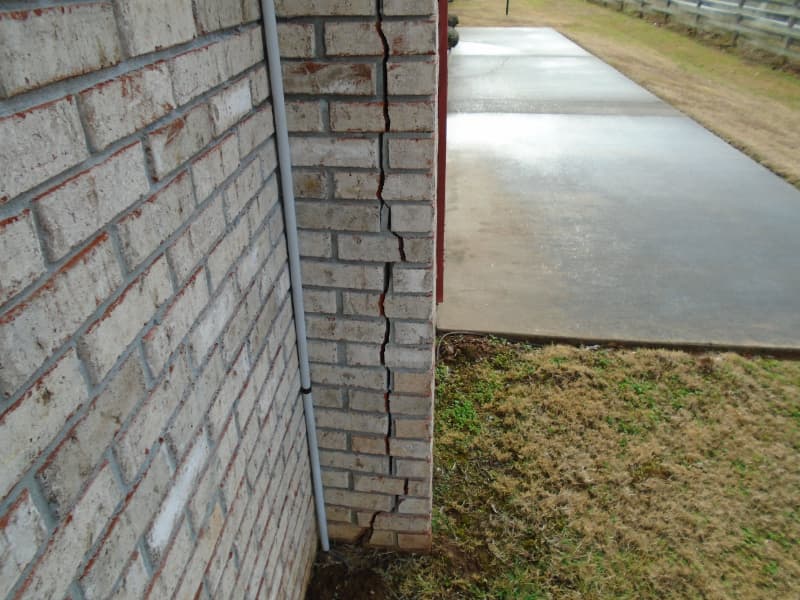1996 single story apartment on slab Alabama. Does not look like settlement per se. Brick footing was cracked as well where visible (about 1.5 inches in view). Any ideas on the cause? For edification purposes, writing the narrative is not the issue.
That is interesting, considering the crack is the same size all the way through, and no offset.
Bingo…like a truck was backed into it (from the inside) ![]()
Not sure what would causation would be without more info.
- What is under the brick?
- Expansive soil?
- Any other areas of cracking?
- Has the subgrade slid towards the low lying area towards the fence?
- Any separation of the wood trim at the top of the brick? Behind the conduit maybe?
- Does a Sumo Wrestler live there??
The crack appears to follow the grout line at the top course back to the corner and is inconsistent at the soil level. There’s got to be more to it…
- What is under the brick? I do not know. I can see a about 1.5 inches of footer
- Expansive soil? Wouldn’t know it if saw it. Poor site drainage for sure though.
- Any other areas of cracking? At various other units, yes. Nothing like this but some interesting finds. I’ll throw in a few pics
- Has the subgrade slid towards the low lying area towards the fence? That patio is stationary IMO
- Any separation of the wood trim at the top of the brick? Behind the conduit maybe? Crack goes behind the frieze, but the trim is intact.
- Does a Sumo Wrestler live there??
The crack appears to follow the grout line at the top course back to the corner and is inconsistent at the soil level. There’s got to be more to it…Agreed!
Just a couple of thoughts:
Is there a footer under that part of the wall, or did they just pour a base for the brick wall?
Did the crack transfer to the slab on the inside?
Hi Richard.
The owner stated the brick footing is separate from the slab. I could not verify.
I did not have access to the interior of this unit. So, we’re flying blind.
The questions were merely hypothetical. Questions I would ask myself if I were there. The simple answer to your original question of causation is movement. Something is moving than shouldn’t be.
Thank you Richard.
Doesn’t appear to be a “V” crack or settlement.
Is this house in an earthquake fault area?
I agree. A bit perplexing. Northern Alabama its its location which I do not believe is a highly seismic region.
That’s most likely the cause, especially if the brick footing is poured in wet soil and/or improperly tied to the slab.
It sure looks like the edge of the slab broke and slipped. The crack in the brick looks clean indicating that it may be fairly recent movement. Definitely a call out for further evaluation.
Since there is no way of telling what the brick is sitting on, whether it be an actual footing, a brick ledge on the slab, a mortar bed that was put on the dirt, or a piece of steel, there is only speculation as to what is going on below grade. I did find it interesting the bottom couple of courses appear to be angled on either side of the crack.

Also I noticed an odd crack in the patio in the back ground.
There is definitely soil movement happening, and the signs do not indicate only settling. If the ground is swelling and heaving upward, even a little, it could cause cracking in brick veneer that is below grade, which in time could transfer up the wall from the bottom. Over several years of miniscule movement up and back down (as the soil swelling retracts) that section of veneer could “walk” out away from the structure leaving a vertical crack like that, kind of like when you go to change a tire and the rim doesn’t just slide right off the hub and has to be walked or wiggled off using a tire spoon (or pry bar) on the bottom.
I have had demolition projects where I got to rip brick veneer off of buildings with a back-hoe (lots of fun btw), and I have seen brick crack in some strange and unpredictable ways when certain pressures are applied.
Brick masonry veneer.
Running bond.
Raker joints. Building bylaw in my province since 1980. No more raked mortar joints with clay units.
Likely due to the contour of the foundation and a fault, no matter what type, the veneer is cracked vertically from the top to the bottom and requires further evaluation and repair remedy.
Observation:
1: Masonry too close to grade.
2: Wide vertical crack, ><5/8", in the veneer.
Recommend:
A licensed masonry contractor:
A: further evaluate and repair the crack in the masonry veneer.
B: provide proper grounds clearance throughout.
I disagree. The veneer is obviously cracked (vertically) from the bottom to the top!
No, not necessarily. A truss/rafter end might be a live load issue.
So you admit that you’re WAG’ing it again!!
Jeffrey, anyone claiming they know the cause is wagging it. It requires a engineer or competent masonry contractor.
Have I repaired masonry veneer walls due to truss loading? Yes. You enter the attic to see if truss or rafter ends are bearing on the veneer. There should be 1" to 2" inches of free space from the timber framed structure and masonry veneer. It would be a different building outcome if the building structure was full structural masonry.




